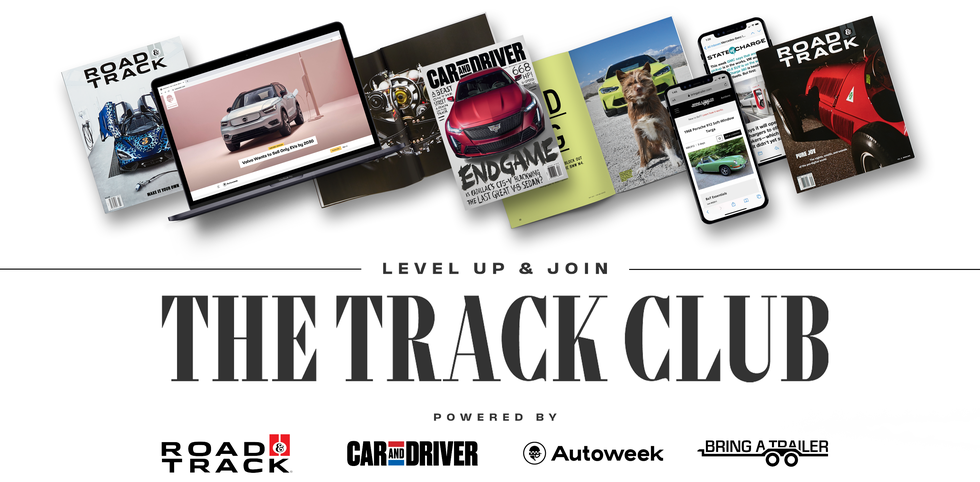I once spied author Tom Wolfe sitting next to a cheap-sunglasses kiosk at Detroit Metro Airport. The maestro of New Journalism and onomatopoeia connoisseur must have been in his mid-eighties by then. His trademark white suit wore him more than he wore it. But this was still the man who’d penned the opening chapter of The Right Stuff, 15 pages of my all-time favorite nonfiction writing.
This story originally appeared in Volume 9 of Road & Track.
SIGN UP FOR THE TRACK CLUB BY R&T FOR MORE EXCLUSIVE STORIES
My wife goaded me to go say hello to the man who published those incandescent words some 35 years earlier. But I let him be.
It’s been my default position in life to never meet my heroes. After all, what good could come of it? What could Wolfe have said that day that would improve on those 15 pages?
I’ve been pretty good at avoiding my organic heroes. My vehicular heroes, though, I have had a harder time eluding. I’ve been lucky enough to chance the destruction of my carefully tended automotive worldview many times. And some- times the experiences have indeed cracked the foundation. Why did I ever think a ’69 Camaro wouldn’t drive like a truck, anyway?
But I’m powerless to resist the temptation. This is how, several years ago, I found myself behind the oddly canted steering wheel of a Ferrari Testarossa (red, of course). So comprehensively did the Testarossa upset the prevailing design orthodoxy when it arrived in 1985 that the sound I associate with it is not the exhaust noise of its flat-12 engine but that of a loud needle scratch. Its crazy cheese-grater side strakes and its absurdly wide, flat, louvered rump made such a deep psychological impact in the period that the design has become as much a visual shorthand for the Eighties as Patrick Nagel’s prints of women with spiky hair and stark white skin. The Testarossa appeared on the cover of this magazine 10 times from December 1984 through July 1989. Every one of them was red, and I had every one of those issues.
How well could this car—or any car—move while freighted with so much cultural baggage and outdated expectation? In the case of the Testarossa at least, the answer is that it moves pretty damn well.
There’s no forgetting that this mid-engine two-seater is from the Cocaine Cowboys era. There’s even a curiously large vanity mirror in the glove box. It’s pure old-school supercar inside. To clear the wide side sills and enter the car, you have to stretch your leg so far that you look like the guy from R. Crumb’s “Keep On Truckin’” cartoon. Then you tuck your feet into the small pedal box that’s shifted radically toward the center of the car. To your right is the gleaming open-gated shifter topped with a shiny black sphere. Gorgeous and recalcitrant, the shifter is classic Ferrari.
For the honor of driving a Ferrari, it’s the driver who’s expected to accommodate the car, not the other way around. The steering wheel is mounted high and angled like that of a delivery van. You’ll just need to get used to that and to the steering system’s lack of power assist, which turns low-speed maneuvers into upper-body workouts. But you can see out of the car, a rarity in the supercar realm. And, once under way, the steering comes alive with lovely feel and a natural touch.
That’s the thing about older performance cars, the Testarossa included: They are not full-spectrum performers like today’s eager-to-please rides. Like the steering, the 4.9-liter flat-12 engine has its preferred operating range. To those who’ve been exposed only to modern turbocharged, cam-phasing engines, the Ferrari’s mill will feel slightly peaky. Power comes on progressively, and when its full 380 hp arrives at 5750 rpm, the thing is making the noise of a large machine at work. Its valvetrain clicks away. Its radiator fans hum. It makes a symphony of the sounds modern NVH engineers seek to eliminate. It makes a mockery of today’s lab-tuned exhaust notes.
The Testarossa is a fully immersive machine. There will be no perfect throttle-blipped downshifts unless you perform them yourself. There will be no saving you if you do something stupid. Ushering the wide-body Testarossa down narrow, twisty roads requires a driver’s full engagement. It is nowhere near as fleet as a modern supercar. But it is in some ways vastly more rewarding.
I love it for different reasons than teenage me thought I would. In a world of electric sedans with four-digit horsepower figures and Toyota Camrys that would whup a Jaguar E-type, the Testarossa’s raw performance no longer inspires awe. Its appeal is more about rediscovering the tactility and linearity that’s been lost over the years. The massive performance gains of the last few decades are stunning. But enjoyment and engagement haven’t necessarily kept pace.
Modern computing power and a backlit, soft-touch keyboard wouldn’t have made Tom Wolfe’s words any better.
1991 Ferrari Testarossa Courtesy of Malcolm Willard.
Daniel Pund took the Executive Editor role at Road & Track in 2020 to help re-invent the venerable magazine brand. For nearly 30 years, Pund has toiled away as a feature writer, car reviewer, editor, and columnist for every car magazine that matters (including Car and Driver and Autoweek) and a few that didn’t. He’s also contributed to Esquire and GQ and other general-interest publications.















